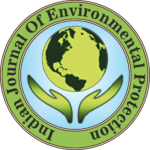IJEP 42(8): 964-970 : Vol. 42 Issue. 8 (August 2022)
Bhumi Bhanushali and Ruby Jalgaonwala*
Shree Ramkrishna Institute of Computer Education and Applied Sciences, Department of Microbiology, Surat, Gujarat, India
Abstract
Algae are vast multifunctional photosynthetic aquatic organisms. the present study aim to investigate application of Oscillatoria spp. for improvement of physico-chemical parameters of dairy wastewater. The results showed to reduce nutrient concentrations from dairy wastewater, such as pH, alkalinity, hardness, TSS, TDS, TS, BOD, COD, oil and grease, by more than 50% alongwith improvement of treatment process by reducing CFU of bacteria present. The ability of Oscillatoria spp. to remove alkalinity was about 80% and for hardness it was more than 50%. Isolated algae not only is prominent in treatment of wastewater but also has potential antioxidants, like catalase and peroxidase alongwith phenols (90 mg/mL), carbohydrates (100 µg/mL) and protein (180 µg/mL), as great reservoir of nutrients. Oscillatoria spp. can act effectively towards control of water pollution.
Keywords
Algae, Oscillatoria spp., Dairy, Wastewater
References
- Matamoros, V., et al. 2016. Assessment of the mechanisms involved in the removal of emerging contaminants by microalgae from wastewater: a laboratory scale study. J. hazard mater., 301:197-205.
- Ruin-Marin, A.L.G., E. Mendoza and T. Stephenson. 2010. Growth and nutrient removal in free and immobilized green algae in batch and semicontinuous cultures treating real wastewater. Bioresour. Tech., 101(1): 58- 64.
- Assayed, A., J. Chenoweth and S. Pedley. 2014. Drawer compacted sand filter: a new and innovative method for on-site grey water treatment. Env. Tech., 35(19): 2435-2446.
- Khan, M.Z., et al. 2017. Microbial electrolysis cells for hydrogen production and urban wastewater treatment: A case study of Saudi Arabia. Appl. Energy. 185: 410-420.
- Harush, D., U. Hampannavar and M. Mallikarjuna-swami. 2011. Treatment of dairy wastewater using aerobic biodegradation and coagulation. Int. J. Env. Sci. Res., 1(1):23-26.
- Li, Y., et al. 2008. Biofuels from microalgae. Biotech. progress. 24(4): 815-820.
- Tabatabaei, M., et al. 2011. Biodiesel production from genetically engineered microalgae: future of bioenergy in Iran. Renew. Sustain. Energy Reviews. 15(4): 1918-1927.
- Nishanthi, R., et al. 2014. Phytochemicals, antimicrobial and antioxidant screening from five different marine microalgae. J. Chem. Pharma. Sci., 52:78-85.
- Gupta, P.L., S.M. Lee and H.J. Choi. 2016. Integration of microalgal cultivation system for wastewater remediation and sustainable biomass production. World J. Microbiol. Biotech., 32(8): 1-11.
- Pearson, H.W., et al. 1987. Physico-chemical parameters influencing faecal bacterial survival in waste stabilization ponds. Water Sci. Tech., 19: 145-152.
- Davies-Colley, R.J., et al. 1999. Inactivation of faecal indicator micro-organisms in waste stabilization ponds. Interactions of environmental factors with sunlight. Waste Res., 33(5): 1220-1230.
- Wei, X., R.C. Viadero and S. Bhojappa. 2008. Phosphorus removal by acid mine drainage sludge treatment plants. Water Res., 42: 3275-3284.
- Zhang, K. and K. Farahbakhsh. 2007. Removal of native coliphages and coliform bacteria from municipal wastewater by various wastewater treatment processes: Implications to water reuse. Water Res., 41: 2816-2824.
- Lembi, C.A. and J.R. Waaland. 1988. Algae and human affairs. Cambridge University Press.
- Thamizh, S.K. and K. Sivakumar. 2012. Ultrastructure and biochemical analysis of Anabaena and Oscillatoria sp. (Cyanabacteria). Int. J. Recent Sci. Res., 3(5):329-335.
- Sanaa, M.M., et al .2012. Aqueous extracts of microalgae exhibit antioxidant and anticancer activities. Asian Pacific J. Biomedicine. (2): 608-615.
- Sanjeet, K., M. Kabi and M. Kumari. 2010. Study on phytochemicals analysis from leaves of Bixa orellana. Emerging Sci., 5(2): 78-85.
- Dubois, M., et al. 1956. Calorimetric method for determination of sugar and related substances. Anal. Chem., 28: 350-356.
- Taga, M.S., E.E. Miller and D.E. Pratt. 1984. Chia seeds as a source of natural lipid antioxidants. J American Oil Chem. Soc., 61: 928-931.
- Lowery, O.H., et al. 1951. Protein measurement with the folin-phenol reagent. J. Biochem., 193: 269- 275.
- Beers, R.F. and I.W. Sizer. 1952. A spectrophotometric method for measuring the breakdown of hydrogen peroxide by catalase. J. Biol. Chem., 195:133-140.
- Reddy, K.P., et al. 1985. Effect of light and benzyladenine on dark treated growing rice (Oryza sativa) leaves. changes in the peroxidase activity. Plant Cell physiol., 26(6): 987-994.
- Oyaizu, M. 1986. Studies on product of browning reaction: Antioxidative activities of product of browning reaction prepared from glucosamine. Japan J. Nutr., 44: 307-315.
- APHA.1998. Standard methods for the examination of water and wastewater (18th edn). American Public health Association, Washington DC.
- Deependra, S., et al. 2012. Potential of treated dairy wastewater for the cultivation of algae and wastewater treatment by algae. Universal J. Env. Res. Tech., 2(1): 101-104.
- Abraham, J. and S. Nanda. 2010. Evaluation of textile effluents before and after treatment with Cyanobacteria. J. Ind. Poll. Cont., 26 (2):149-152.
- Vijayakumar, S. 2012. Potential applications of Cyanobacteria in industrial effluents-A review. J Bioremed. Biodeg., 3:154.
